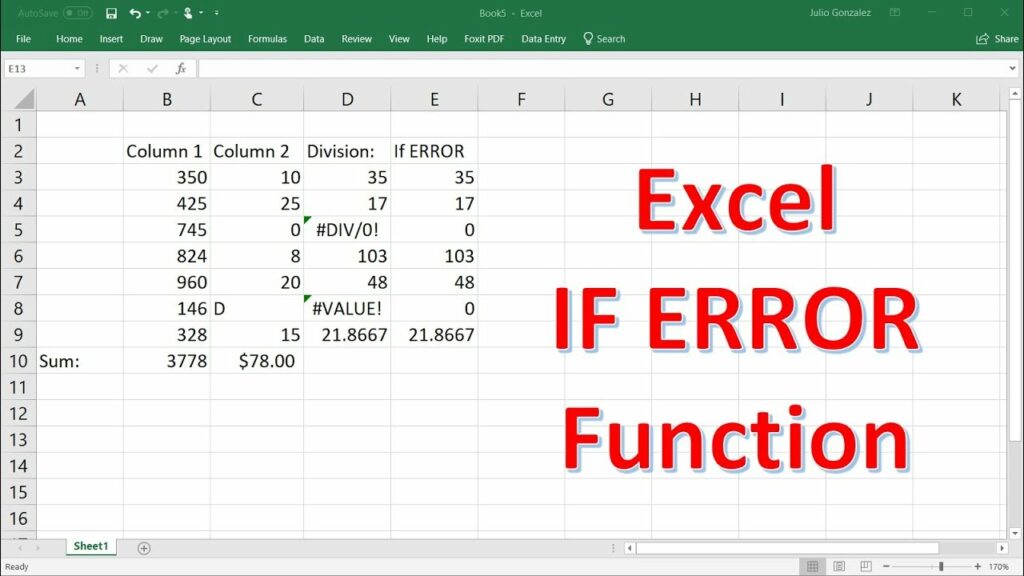Mastering the IFERROR Function in Excel: A Comprehensive Guide

Excel is a powerful tool for data analysis, but dealing with errors in formulas can be frustrating and time-consuming. Fortunately, Excel provides several functions to handle errors effectively, and one such function is IFERROR. The IFERROR function allows you to replace error values with a specified result, making your spreadsheets more robust and user-friendly. In this comprehensive guide, we will explore everything you need to know about using the IFERROR function in Excel, from basic syntax to advanced techniques and real-world applications.
Table of Contents
- Introduction
- Benefits of Using the IFERROR Function
- Basic Syntax and Usage
- Practical Examples
- Handling Division Errors
- Dealing with #N/A Errors
- Masking Errors in Complex Formulas
- Advanced Techniques
- Nesting IFERROR Functions
- Using IFERROR with Other Functions
- Handling Errors
- Common Errors and Troubleshooting
- Ensuring Data Integrity
- Tips and Tricks
- Using Named Ranges
- Utilizing Keyboard Shortcuts
- Real-World Applications
- Financial Modeling
- Data Analysis
- Reporting
- Best Practices
- Understanding Error Types
- Documenting Error Handling
- Regularly Testing Formulas
- Conclusion
1. Introduction
The IFERROR function in Excel is a powerful tool for handling errors in formulas. It allows you to specify a value or action to take if a formula returns an error, such as #DIV/0!, #N/A, #VALUE!, or #REF!. By using IFERROR, you can prevent errors from disrupting your calculations and ensure that your spreadsheets produce accurate and reliable results.
2. Benefits of Using the IFERROR Function
- Error Handling: Easily handle errors in formulas without disrupting the flow of your calculations.
- Improved Readability: Make your spreadsheets more user-friendly by replacing error values with meaningful messages or alternative results.
- Efficiency: Save time and effort by automating error handling instead of manually troubleshooting errors.
- Data Integrity: Ensure that your spreadsheets produce accurate results even in the presence of errors.
3. Basic Syntax and Usage
The basic syntax of the IFERROR function is straightforward:
=IFERROR(value, value_if_error)
- value: The formula or expression that you want to evaluate.
- value_if_error: The value or action to take if the formula returns an error.
4. Practical Examples
Handling Division Errors
To handle division errors (e.g., #DIV/0!) gracefully:
=IFERROR(A1/B1, "Division Error")
Dealing with #N/A Errors
To replace #N/A errors with a specific value or message:
=IFERROR(VLOOKUP(A1, B:C, 2, FALSE), "Not Found")
Masking Errors in Complex Formulas
To mask errors in complex formulas and display a default value instead:
=IFERROR(SUM(A1:A10) / COUNT(A1:A10), 0)
5. Advanced Techniques
Nesting IFERROR Functions
You can nest IFERROR functions to handle multiple types of errors:
=IFERROR(IFERROR(A1/B1, "Division Error"), "Other Error")
Using IFERROR with Other Functions
Combine IFERROR with other Excel functions for more advanced error handling:
=IFERROR(INDEX(DataRange, MATCH(LookupValue, LookupRange, 0)), "Not Found")
6. Handling Errors
Common Errors and Troubleshooting
- #DIV/0! Error: This error occurs when you attempt to divide by zero.
- #N/A Error: This error occurs when a value is not available, such as when using the VLOOKUP function.
- #VALUE! Error: This error occurs when a formula contains invalid data types or operands.
Ensuring Data Integrity
- Error Checking: Regularly check for errors in your formulas and verify the accuracy of your results.
- Input Validation: Use data validation to ensure that input values are valid and within acceptable ranges.
7. Tips and Tricks
Using Named Ranges
Define named ranges for input data and error messages to make your formulas more readable and easier to maintain.
Utilizing Keyboard Shortcuts
- F9: Use this shortcut to evaluate parts of your formula individually and identify where errors occur.
- Ctrl + Shift + Enter: Use this shortcut to enter array formulas that handle multiple values at once.
8. Real-World Applications
Financial Modeling
Handle errors in financial models gracefully to ensure accurate calculations and reliable results.
Data Analysis
Prevent errors from disrupting data analysis workflows by using IFERROR to handle errors in formulas.
Reporting
Create error-free reports with accurate and reliable results by using IFERROR to handle errors in formulas and calculations.
9. Best Practices
Understanding Error Types
Familiarize yourself with common error types in Excel and learn how to handle them effectively using IFERROR.
Documenting Error Handling
Document your error handling strategies and the rationale behind them to make your spreadsheets more transparent and understandable.
Regularly Testing Formulas
Regularly test your formulas and error handling mechanisms to ensure that they are working correctly and producing accurate results.
10. Conclusion
The IFERROR function in Excel is a powerful tool for handling errors in formulas and ensuring the accuracy and reliability of your spreadsheets. By mastering the basics, exploring advanced techniques, and following best practices, you can make your spreadsheets more robust, user-friendly, and error-free. Whether you’re building financial models, analyzing data, or creating reports, IFERROR can help you handle errors gracefully and produce accurate results that you can trust.
By leveraging the capabilities of the IFERROR function and integrating it into your Excel workflows, you can save time, improve efficiency, and enhance the quality of your work. Practice the examples and techniques provided in this guide to become proficient in using IFERROR, and explore how it can help you build more reliable and error-free spreadsheets for your data analysis and reporting needs.




